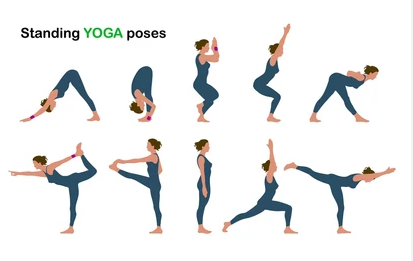A KEGEL: WHAT IS IT?
Exercises for the pelvic floor, often known as Kegel exercises, aid in strengthening these muscles. Your vagina, colon, and bladder are among the organs in your pelvis that your pelvic floor muscles support for Kegels for women. Your pelvic floor muscles support the position of your organs and aid in urinating, defecating, and having sex. Exercises improve your pelvic floor muscles by first tightening and then relaxing them Kegel exercises for men.
Kegel exercises can assist with issues like:
- Urinary incontinence, or urine leaking.
- Impertinence (an urgent need to go potty).
- Incontinence in the bowels (leaking poo).
Pelvic organ prolapse is the term for the pelvic organs protruding or dropping into the vagina exercises can also help you have better orgasms and enhance your sexual health and bladder control exercises. Men and women who were born with a male or female gender designation (AMAB or AFAB, respectively) can benefit from Kegel.

DIRECTIONS FOR DOING A KEGEL-
Men and women can benefit from strengthening their pelvic floor muscles in a variety of ways.
- It permits the rectum, anus, uterus, and bladder to operate normally.
- Stops urine from leaking in those with “stress incontinence” (leakage when sneezing, laughing, coughing, or straining).
- Helps those who experience “urinary urgency” or “urge incontinence” by controlling the unexpected need to urinate.
- It regulates bowel motions and gas discharge.
Method for performing Kegel exercises-
It’s crucial to understand which muscles to tension; the following are some helpful techniques:
- Squeeze the muscles you would use to stop yourself from passing gas, whether you are a man or a woman.
- Individuals with a female anatomy should squeeze the muscles surrounding their finger after putting it within the vagina or picture yourself needing to use your vagina to raise a marble that you are sitting on Kegel exercises for men.
- Squeeze the muscles that regulate the flow of pee if you have male anatomy.
The muscles involved in pelvic floor exercises are not found in the thighs, abs, or buttocks, regardless of how you choose to perform them. You can practice in any posture (standing, sitting, or lying down) once you know which muscles to contract with bladder control exercises.
An example of a Kegel schedule-
Always start small and work your way up while beginning a Kegel exercise. You won’t be able to hold your Kegel for more than five or ten seconds at first. You also can’t anticipate outcomes immediately with kegels for women.
This is an example of a beginner’s Kegels routine:
- Locate the pelvic floor muscles first (by following the aforementioned procedures).
- Your pelvic floor muscles should first contract for three seconds, followed by a three-second relaxation period. Kegel is this person.
- Try to do this ten times over. If ten seems too difficult, start with five and work your way up to 10. We refer to this as a set.
- Complete two sets: one in the morning and one at night.
- Strive to raise these figures as your strength increases. For instance, hold and release for five seconds each time rather than three seconds of Kegels followed by three seconds of relaxation.
- Then, if it’s not already the case, raise the amount of consecutive Kegels to ten. Lastly, increasing the frequency of these workouts from twice daily to three times daily.
Eventually, you should be able to perform three sets of ten Kegels a day, holding and relaxing for five seconds between each set.
Male benefits of Kegel exercises-
Numerous illnesses, such as diabetes and an overactive bladder, as well as medical procedures like radical prostatectomy, can damage your pelvic floor muscles for kegels for women.
You can benefit from Kegel exercises if:
- You experience fecal or urine incontinence.
- Drip after using the loo, ideally after you’ve finished.
How should guys perform Kegel exercises?
Start with :
- Locate the appropriate muscles. Stop urinating in the middle of the stream or tense the muscles preventing you from passing gas to find your pelvic floor muscles with bladder control exercises. The pelvic floor muscles are used in these exercises. You can practice the exercises in any position once you’ve determined which muscles in your pelvic floor are engaged, though initially, it might be most comfortable for you to lie down with a Kegel.
- Remain focused. If you concentrate solely on contracting the pelvic floor muscles, you will get the most benefits. Take cautious not to flex your buttocks, thighs, or abdominal muscles. Do not hold your breath. Rather, during the workout, breathe freely with kegel exercises for men.
- Three times a day, repeat. Try to complete three sets of ten reps or more each day.
When to perform your Kegel exercises and what happens ?
Include exercises in your everyday regimen. As an illustration:
- Perform a series of it each time you perform a daily chore, like brushing your teeth.
- To get rid of the last few traces of urine, perform another set after urinating.
- Before and during any activity that puts pressure on your abdomen, such as sneezing, coughing, laughing, or lifting heavy weights, contract your pelvic floor muscles.
Within a few weeks to months, regular Kegel exercise practice should show results, such as less frequent urine. Include exercises into your regular regimen for long-term advantages with kegel exercises for men.
How to perform women’s Kegel exercises?
Start with :
- Locate the appropriate muscles. Pause mid-urination to identify the muscles of the pelvic floor. You can practice the exercises in any position once you’ve determined which muscles in your pelvic floor are engaged, though initially it might be most comfortable for you to lie down for kegels for women.
- Develop your method. Imagine that you are sitting on a marble. To execute Kegels, engage your pelvic muscles as though you were lifting the marble. repeat this for three seconds in a row, then take a three-second break.
- Remain focused. If you concentrate solely on contracting the pelvic floor muscles, you will get the most benefits. Take cautious not to flex your buttocks, thighs, or abdominal muscles. Do not hold your breath. Rather, during the workout, breathe freely.
- Three times a day, repeat. Try to get in three sets of ten to fifteen reps or more each day.
Within a few weeks to months, regular exercise practice should show results, such as less frequent urine. Include exercises into your regular regimen for long-term advantages for bladder control exercises.
When to make a doctor’s appointment ?
If you are unsure whether you are practicing Kegel exercises correctly, speak with your healthcare professional. To make sure you are completing them correctly, your provider can verify. A physiotherapist with expertise in pelvic floor exercises might be recommended to you.
HOW OFTEN ARE KEGEL EXERCISES Performed?
Attempting to complete ten sets of the workout three times a day is a typical strategy:
- Tighten your pelvic muscles.
- Tighten your muscles for ten or so seconds.
- Let your muscles get entirely relaxed.
Maintain this schedule for several months at minimum. Results should become apparent a few weeks to months after you begin with kegels for women.
For what amount of time is a Kegel held correctly?
Only perform as many Kegel exercises as you find reasonably easy at first. Say you perform five Kegel exercises twice a day, holding each one for three seconds. Increase these numbers gradually as your strength for kegel exercises for men and endurance improve for bladder control exercises. Eventually, you should be able to hold the Kegels for five seconds and then release the muscles for the same amount of time. At least twice or three times a day, repeat this up to ten times with kegel.



